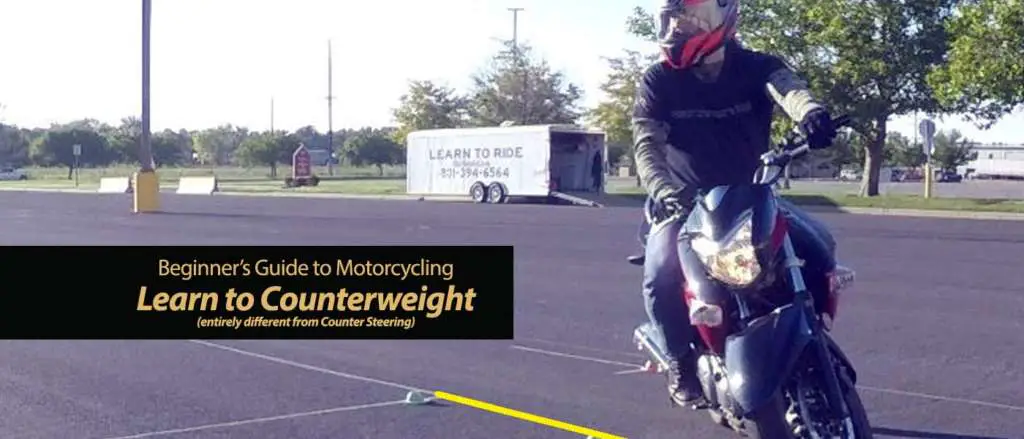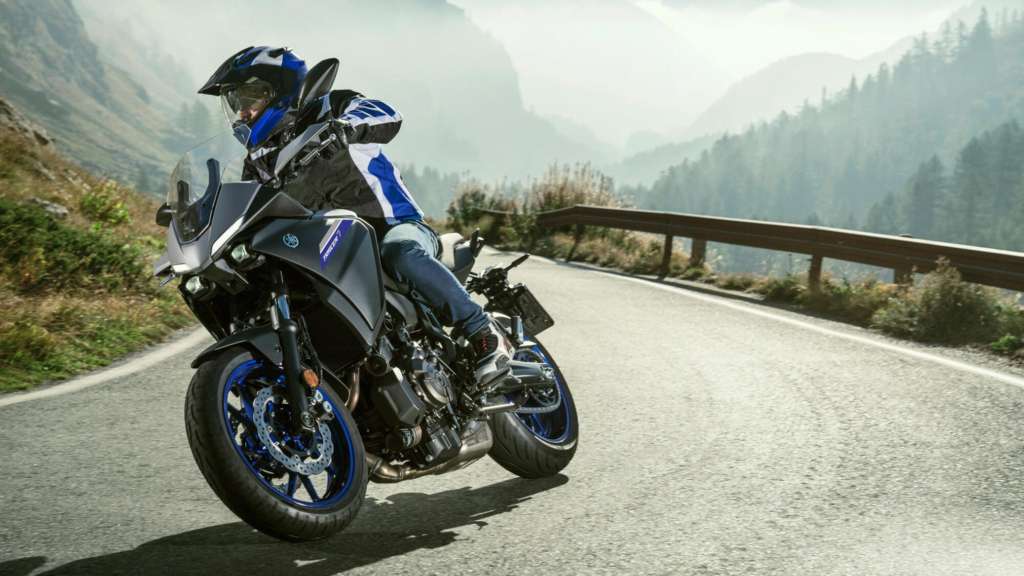
Section 5.5: Counter Steering, Push Steering the Easy way.
One of the most important new skills a rider learns is how to Counter Steer or Push Steer correctly with confidence. Some have problems with the technique, some are timid and others just were never taught properly.
I like using the work “Push Steering” rather than “Counter Steering” because it is easier to visualize and imagine.
Push Steering is when you want to turn (lean) the bike at speeds over 20km/h. While you can do all sorts of things to turn the motorcycle rather than push steer, push steering works the best of all. It should be practiced until done with confidence and correctly because it is very important skill to have. Once you have read this article I believe it will bring your confidence right up!
Counter/Push Steering the Easy Way – Learning to Ride
It is best to practice in a parking lot or in an area without other cars and on clean pavement. Setting up cans or cones to make a turn is a good idea that will help you out.
– The MOST IMPORTANT THING about building confidence in counter-steering (push steering) is…
– Review
– Websites
The MOST IMPORTANT THING about building confidence in counter-steering (push steering) is…
Motorcycles always want and are the happiest being straight up from the ground when the front tire is rotating (when you are moving). This is true because of the gyroscopic effect of the front wheel spinning around. Remember playing with a gyroscope when you were little and how hard it was to upset its balance from spinning straight up? Well that is same with a motorcycle as well!
Basic Explanation: As the gyroscope spins, the force of the spinning causes the gyroscope to want to stay upright and be stable.
As with the motorcycle tire: As the front motorcycle tire spins, the force of the spinning causes the motorcycle body to want to stay upright and be stable.
What happens when you push steer (counter-steer) is you only temporarily (as long as you are pushing on the bar) leaning the motorcycle to the left or right while looking where you want to go. It requires MORE force to lean the motorcycle to the left or right than it does to bring it straight back up because of the gyroscopic effect. Thus the motorcycle always wants to be stable and will bring itself back up right and therefore the motorcycle won’t fall down.
By looking as far into the turn (where you want to go) as you can, you assure yourself of making the whole push-steering job easier on yourself! You will always go where you look (or look at), so why not look into the turn rather than stare at the ground or a few feet ahead? Why make it more difficult on yourself!
So will the motorcycle ever fall completely over push steering? If by “fall” you are meaning skidding it sideways (off the tires) so you do not have any tire grip anymore than yes. BUT it would require quite an extreme lean angle that you would have to do this on purpose before it would happen. And thanks to other things getting in the way (pegs, exhaust, side/canter stand) that these things would touch the ground long before you ran out of tire traction! Even if these things scrape the ground you still have good control and it is a breeze to bring the back back straight up! These are turns motorcycle racers do around track corners and if you are starting to scope things on the ground in a turn, then you mastered push steering beyond the scope of this article!
Now, that is an Extreme lean and the motorcycle still has not fallen over! Note that they are looking into the turn, not directly in front of them.
So let’s Review:
– Motorcycles are extremely stable machines that highly prefer to travel straight up from the ground thanks to the rotating front wheel causes a highly stable gyroscopic effect.
– To push steer, push on the bar the way to want to turn. Push right to go right, push left to go left.
– It requires more force to temporarily lean (turn) the motorcycle than it does to bring it back up. In fact, the motorcycle will do it almost 100% on its own!
– To push steer you need to be going 20km/h or greater.
– It is extremely difficult (0.001% chance) to have the bike fall down without doing it on purpose.
– Always Look as far down the turn where you want to go to make push steering easier on yourself.
Steering – Rake and Trail
What makes one motorcycle turn better than another one? What is heavy steering? What is rake and trail any ways?
Rake is the angle between the headset tube and a vertical line. Increasing the rake will move the front tire farther from the bike. Rake is measured in degrees, and is a frame specification. To visualize trail, draw an imaginary line along the path of the headset tube to the ground. Measure from this point to the center of the tire patch. This is trail, and is measured in inches.
The amount of rake is significant in determining a motorcycle’s handling characteristics. In general, more rake provides greater straight line stability, less rake makes the bike more responsive. Larger values of trail also create more straight line stability. This is why the forks on a sportbike are more vertical than those of a cruiser.
Typical Cruiser Dimensions (2003 Honda VTX1800)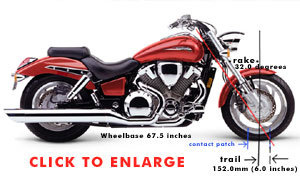
Rake 32.0 degrees
Trail 152.0mm (6.0 inches)
Wheelbase 67.5 inches
Therefore: With a rake of 32 degrees and a trail of 152mm (6 inches) this motorcycle will be better and more stable in a straight line than turning a tight corner. The long wheelbase of 67.5 inches also assists this motorcycle again in straight line performance but will hinder it in cornering. So this motorcycle has been properly designed for it’s intended purpose (touring, cruising, and highway use).
Typical Sport Bike Dimensions (2003 Honda CBR600RR)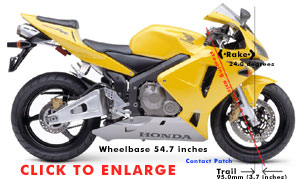
Rake 24.0 degrees
Trail 95.0mm (3.7 inches)
Wheelbase 54.7 inches
Therefore: With a rake of 24 degrees and a trail of 95mm (3.7 inches) this motorcycle will turn much quicker and sharper than the Cruiser, but will not be as good or as stable in a straight line. The short wheelbase of 54.7 inches also assists this motorcycle again in cornering but hinders straight line stability. So this motorcycle has been properly designed for it’s intended purpose (going in and out of corners at high speeds and taking twisty roads).
Visualize the wheels of a shopping cart for an illustration of a machine with zero rake and a lot of trail. Exciting handling, but zero straight line stability.
COUNTERWEIGHTING: Tight Turns, Tight Skills.
One of the best tools in a motorcyclists’ arsenal is the low-speed maneuver known as counterweighting. This technique can help you manage your bike in small spaces like parking lots or driveways, and keep you safe and precise when turning at intersections. Best of all, it’s easy to learn. Read on to learn how to apply this skill to your riding. Total Motorcycle Beginner’s Guide to Motorcycling is your best resource to learn and improve your riding skills.
WRONG RIGHTS
It was a video shared in one of my Facebook groups that prompted me to write this article.
In the video, we see a divided highway with a grassy median, two lanes of travel in both directions. The camera is facing up the road towards a T intersection, where a procession of bikes is queued up to make a right turn. A lead rider rolls out to block traffic, as they do, and some fifty bikes make the right turn and ride down the road towards the camera. They wave as they pass.
What strikes me about the video is not the huge procession of bikes. It is not the bikes themselves, how majestic or impressive they look. It is not even the questionable practice of a citizen blocking traffic, which really ought to be done by a police escort. No, the thing about the video that stuns me is the right turn. Some four of ten bikes completely blow the corner, passing a foot or more into the further lane. Four in ten of these riders can’t complete a 90 degree right turn with a 10’ radius. I wonder what they do when they’re out riding on their own, without a blocker.
“In the same way that leaning our body into a turn can help us take it faster, leaning out of a turn can help us take it slower. We call this counterweighting.”
EXCUSES
It’s not their fault. I don’t think they’re poor or inattentive riders. I just think they’re struggling under a handful of incorrect stories motorcyclists sometimes tell themselves. It starts with ‘my bike is too big for tight turns’, and ends with ‘just don’t park where you can’t get out.’ Lots of stops in-between. For whatever reason, low-speed maneuvers in tight spaces tend to be dismissed as either unnecessary or too difficult. Fortunately, we don’t have to keep laboring under these false notions. There are situations where a poorly executed TFS (turn from stop) can get you hurt, so it’s a necessary skill to learn. There is an easy, effective technique to help you master them, so it’s not too difficult. And this technique works with any size bike.
It’s called…
COUNTERWEIGHTING*
*-not to be confused with countersteering, an entirely different technique for an entirely different situation
In the same way that leaning our body into a turn can help us take it faster, leaning out of a turn can help us take it slower. We call this counterweighting, and it can be effective both while moving and from a standstill. Please note that counterweighting is only appropriate at very low speeds, from a crawl to about 8mph. Anything faster than that and you want to use your normal cornering technique, which should be countersteer.
COUNTERWEIGHTING WHILE ROLLING
As you approach a turn, you want to first create some slack in your elbows by leaning forward at the waist. This will give you the extra reach you’ll need. Next is the head turn. This is vital. Your bike will go where your chin is pointing, so point it where you want to go. And point it all the way. If you intend to turn all the way around, turn your head all the way around. Look where you intend to be when the turn is complete.
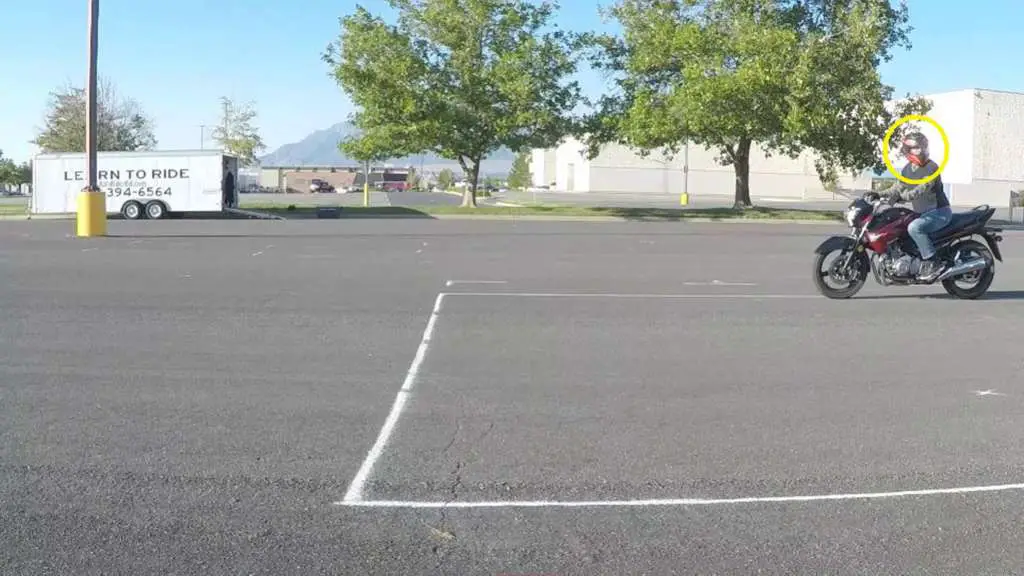
So now we’re leaned forward, and our head is turned in the direction we want to go. Start to turn your bars (not lean them, we turn the bars at low speeds), and as you do, lean out from the turn by shifting weight to your outside foot peg. Your upper body should swivel in the direction of the turn as you do this, because your outside arm is extending. You’ll find the further out you lean your body from the apex of the turn, the deeper you can angle the bike into it. With practice, it’s easy to get to full lock.
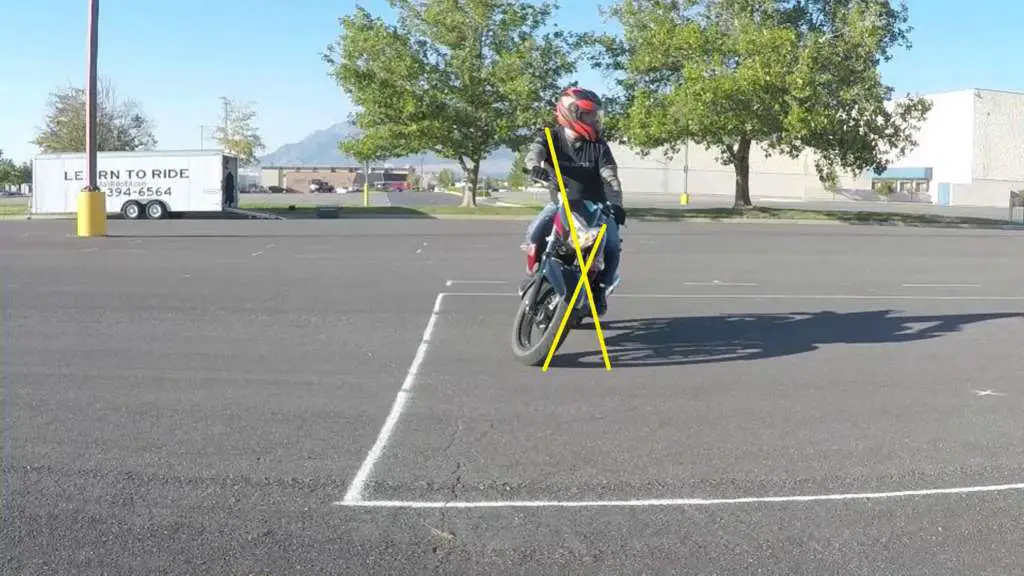
If you’re on a bike with an extremely laid-back riding position, it might be a little harder to feel your way through this. You can’t really push down on a footpeg when it’s clear out in front of your knee, right? So instead of transferring weight like that, initiate your lean by pushing against the tank with your outside knee. This will create the brace point you need to lean your upper body out.
This technique really is easy to learn, and it’s instantly effective once you’ve picked it up. But the absolute best way to develop this skill is under the trained eye of an MSF RiderCoach.
COUNTERWEIGHTING FROM A STANDSTILL
To initiate a counterweight turn from a standstill, begin with your handlebars turned slightly into the turn. Lean your upper body out, but also rotate so your chest is pointed into the turn. Load in just a little bit of throttle before you start to release the clutch, which will make your friction point a little more grabby, and then go. Once your feet are up, weight to the outside with either your peg or your knee, and continue to look through the turn.
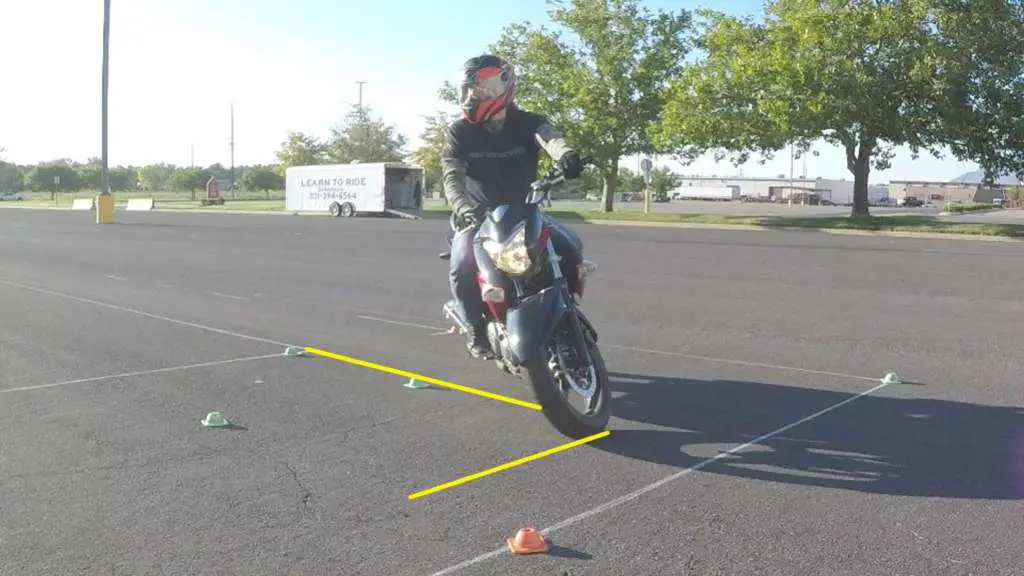

BUT SO-AND-SO SAID…
Poke around on the internet a bit, and you’re sure to find an argument against counterweighting. The one I’ve heard most often goes like this. “Counterweighting gives up ground clearance, I’d rather take the turn faster with some lean angle.” And they’re not kidding. I have seen a video of a rider making a continuous low-speed 20’ circle with a knee down. A neat parlor trick, sure. But it wont work from a dead standstill at an intersection. Also, frankly, it just seems like a lot of work. I mean, you could also just stop the bike, pick it up, and turn it around, but it might take years to training to be able to do that. Right Matt? But If you can stand on one foot, you can counterweight a bike.
YOU NEED PROFESSIONAL HELP
This technique really is easy to learn, and it’s instantly effective once you’ve picked it up. But the absolute best way to develop this skill is under the trained eye of an MSF RiderCoach. Head over to http://www.msf-usa.org to find an accredited MSF provider in your area. And if you’re in my neck of the woods, Utah, check out Utah Rider Ed, the school I teach with. If you’re new to motorcycling, sign up for the Basic RiderCourse (BRC). If you’ve been riding for a while now, look in to a BRC2. In either case, they will teach you all kinds of useful skills in addition to counterweighting.


